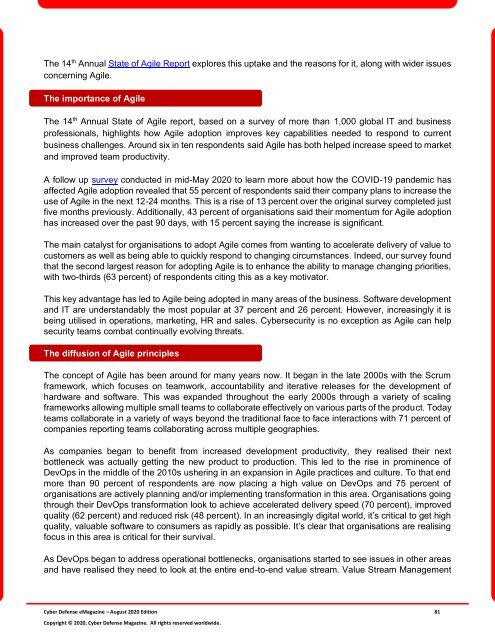Cyber Defense eMagazine August 2020 Edition
Cyber Defense eMagazine August Edition for 2020 #CDM #CYBERDEFENSEMAG @CyberDefenseMag by @Miliefsky a world-renowned cyber security expert and the Publisher of Cyber Defense Magazine as part of the Cyber Defense Media Group as well as Yan Ross, US Editor-in-Chief, Pieruligi Paganini, Co-founder & International Editor-in-Chief, Stevin Miliefsky, President and many more writers, partners and supporters who make this an awesome publication! Thank you all and to our readers! OSINT ROCKS! #CDM #CDMG #OSINT #CYBERSECURITY #INFOSEC #BEST #PRACTICES #TIPS #TECHNIQUES
Cyber Defense eMagazine August Edition for 2020 #CDM #CYBERDEFENSEMAG @CyberDefenseMag by @Miliefsky a world-renowned cyber security expert and the Publisher of Cyber Defense Magazine as part of the Cyber Defense Media Group as well as Yan Ross, US Editor-in-Chief, Pieruligi Paganini, Co-founder & International Editor-in-Chief, Stevin Miliefsky, President and many more writers, partners and supporters who make this an awesome publication! Thank you all and to our readers! OSINT ROCKS! #CDM #CDMG #OSINT #CYBERSECURITY #INFOSEC #BEST #PRACTICES #TIPS #TECHNIQUES
You also want an ePaper? Increase the reach of your titles
YUMPU automatically turns print PDFs into web optimized ePapers that Google loves.
The 14 th Annual State of Agile Report explores this uptake and the reasons for it, along with wider issues<br />
concerning Agile.<br />
The importance of Agile<br />
The 14 th Annual State of Agile report, based on a survey of more than 1,000 global IT and business<br />
professionals, highlights how Agile adoption improves key capabilities needed to respond to current<br />
business challenges. Around six in ten respondents said Agile has both helped increase speed to market<br />
and improved team productivity.<br />
A follow up survey conducted in mid-May <strong>2020</strong> to learn more about how the COVID-19 pandemic has<br />
affected Agile adoption revealed that 55 percent of respondents said their company plans to increase the<br />
use of Agile in the next 12-24 months. This is a rise of 13 percent over the original survey completed just<br />
five months previously. Additionally, 43 percent of organisations said their momentum for Agile adoption<br />
has increased over the past 90 days, with 15 percent saying the increase is significant.<br />
The main catalyst for organisations to adopt Agile comes from wanting to accelerate delivery of value to<br />
customers as well as being able to quickly respond to changing circumstances. Indeed, our survey found<br />
that the second largest reason for adopting Agile is to enhance the ability to manage changing priorities,<br />
with two-thirds (63 percent) of respondents citing this as a key motivator.<br />
This key advantage has led to Agile being adopted in many areas of the business. Software development<br />
and IT are understandably the most popular at 37 percent and 26 percent. However, increasingly it is<br />
being utilised in operations, marketing, HR and sales. <strong>Cyber</strong>security is no exception as Agile can help<br />
security teams combat continually evolving threats.<br />
The diffusion of Agile principles<br />
The concept of Agile has been around for many years now. It began in the late 2000s with the Scrum<br />
framework, which focuses on teamwork, accountability and iterative releases for the development of<br />
hardware and software. This was expanded throughout the early 2000s through a variety of scaling<br />
frameworks allowing multiple small teams to collaborate effectively on various parts of the product. Today<br />
teams collaborate in a variety of ways beyond the traditional face to face interactions with 71 percent of<br />
companies reporting teams collaborating across multiple geographies.<br />
As companies began to benefit from increased development productivity, they realised their next<br />
bottleneck was actually getting the new product to production. This led to the rise in prominence of<br />
DevOps in the middle of the 2010s ushering in an expansion in Agile practices and culture. To that end<br />
more than 90 percent of respondents are now placing a high value on DevOps and 75 percent of<br />
organisations are actively planning and/or implementing transformation in this area. Organisations going<br />
through their DevOps transformation look to achieve accelerated delivery speed (70 percent), improved<br />
quality (62 percent) and reduced risk (48 percent). In an increasingly digital world, it’s critical to get high<br />
quality, valuable software to consumers as rapidly as possible. It’s clear that organisations are realising<br />
focus in this area is critical for their survival.<br />
As DevOps began to address operational bottlenecks, organisations started to see issues in other areas<br />
and have realised they need to look at the entire end-to-end value stream. Value Stream Management<br />
<strong>Cyber</strong> <strong>Defense</strong> <strong>eMagazine</strong> – <strong>August</strong> <strong>2020</strong> <strong>Edition</strong> 81<br />
Copyright © <strong>2020</strong>, <strong>Cyber</strong> <strong>Defense</strong> Magazine. All rights reserved worldwide.


















